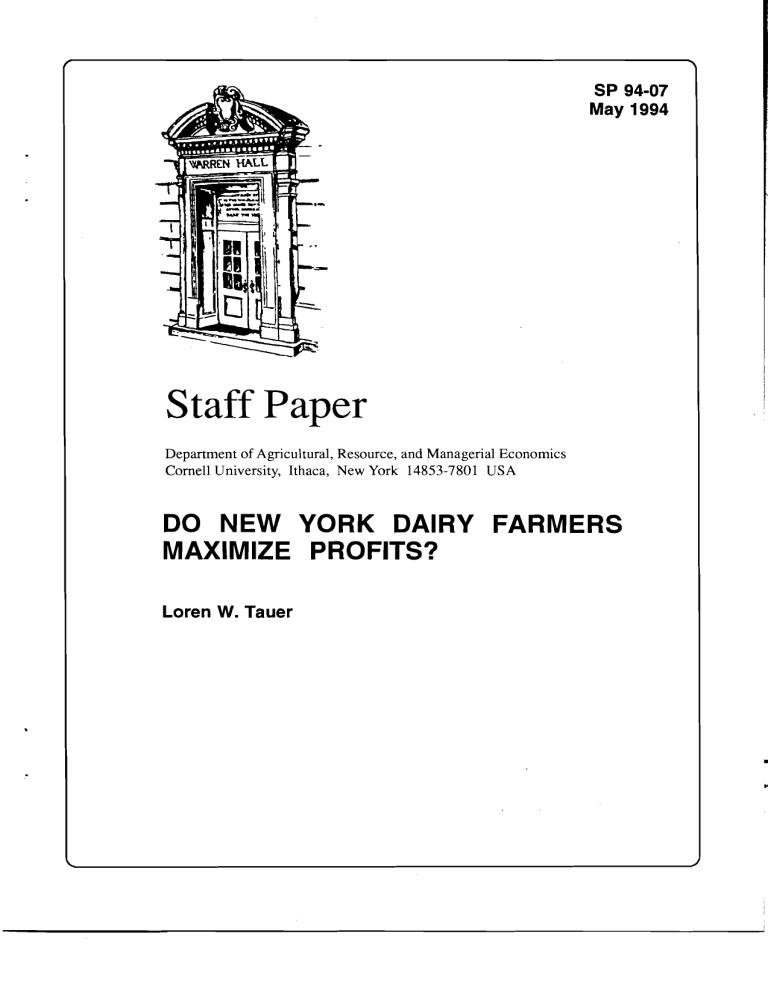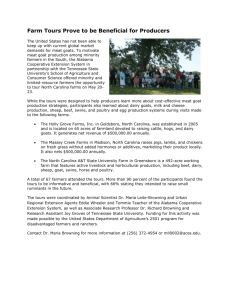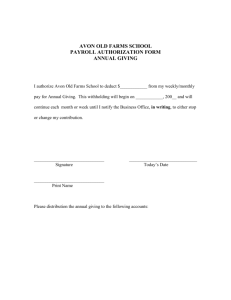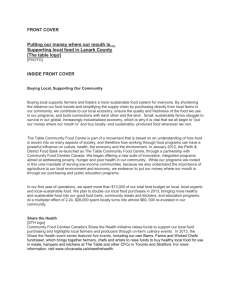Document 11951837

SP 94-07
May 1994
Staff Paper
Department of Agricultural, Resource, and Managerial Economics
Cornell University, Ithaca, New York 14853-7801 USA
DO NEW YORK DAIRY FARMERS
MAXIMIZE PROFITS?
Loren W. Tauer
•
It is the policy of Cornell University actively to support equality of educational and employment opportunity. No person shall be denied admission to any educational program or activity or be denied employment on the basis of any legally prohibited dis crimination involving, but not limited to, such factors as race, color, creed, religion, national or ethnic origin, sex, age or handicap. The University is committed to the maintenance of affirmative action programs which will assure the continuation of such equality of opportunity. l
Do New York Dairy Farmers Maximize Profits?
Loren W. Tauer'
Abstract
Varian's Weak Axiom of Profit Maximization was used to determine whether each of 49 New York dairy farms displayed behavior consistent with profit maximization. The results indicate that most were only moderately successful in maximizing profits.
Characteristics of the farms did not strongly differentiate those that were better at maximizing profits.
, Professor, Department of Agricultural, Resource, and Managerial Economics, Cornell
University, Ithaca, NY. Paper presented at the annual meeting of the American Agricultural
Economics Association in San Diego, CA, August 7-10, 1994. The author thanks Wayne
Knoblauch and Alfons Weersink for their comments.
•
Do New York Dairy Farmers Maximize Profits?
The ability of farmers to maximize profits is of paramount importance in applied economic analysis. In these analyses, it is typically assumed that farmers not only try to maximize profits, but that they are successful. This is the underlying assumption in derived output supply and input demand functions which are used in price and welfare analysis.. Deviations from successful profit maximization can bias empirical results.
Do farmers attempt to maximize profits and are they successful? With perfect information, most economists would accept profit maximization as an important, if not the primary, objective of most farmers. In a nonperfect world with uncertainty, Simon, among others, has argued for alternative theories, which generally fall under the concept of bounded rationality (Stiglitz). Farmers are rational, but since they do not have perfect information their decision results deviate from the profit maximizing paradigm.
The purpose of this research is to determine how close a group of New York dairy farms comes to displaying profit maximization behavior. This will be tested using the nonparametric approach to production analysis championed by Varian. If these farmers do not display behavior consistent with profit maximization, as determined by their selection of input and output quantities, it can be concluded that either they are not very successful at maximizing profits or that profit maximization is not their objective. Recent applications of nonparametric production analysis in agriculture include work by Fawson and Shumway, Chavas and Cox. Those efforts used aggregated regional or U.S. data, rather than firm-level data as used here.
•
2
Nonparametric Production Theory
Much of the recent interest and development in the nonparametric approach to production analysis is attributed to Varian (1984), but the initial effort was formalized by
Afriat. In that work, they specify what empirical evidence would support the hypotheses of profit maximization behavior.
Define the netput vector for period i as yi = (y/, ... , Yn i
), i=l, ..., m, where y...
i is an output if y...
i
> 0 and an input if y...
i
< O. An associated price vector is defined as pi = (p~, ..., p~), where each p~
2: 0 denotes the price associated with each respective element of yi.
If we observe a set of price vectors, pt and netput vectors, y\ for t=l, ..., T, then the hypothesis of period-by-period profit maximization can be tested. A necessary condition for these data to be consistent with profit maximization is that pty t 2: pty
S, for all s and t.
This inequality states that the profit using the price and netput vectors from any given year must be at least as great as using the price vector from that given year and the netput vector from a different year. It tests whether given the price vector for a given year the firm was successful in selecting the input and output quantities that maximized profits. Varian (1984) refers to this as the Weak Axiom of Profit Maximization
(W APM). It is a test that imposes no functional form on the data.
Although the data used can be cross-sectional, with firms operating in different markets, and thus facing different price vectors and choosing different netput vectors, most analyses utilize time series data. The difficulty with using time series data is that
..
3 technological change is a factor. As Varian (1990) states, if most violations of WAPM indicate that the finn would be better off at time t making a choice that was made at some later date, then technological progress or learning-by-doing may be involved; the more profitable choices were not made at time t because they were not available.
However, if we go backwards and find those netput vectors are more profitable, then we must conclude that the finn did not maximize profits at time t.
Varian (1990) indicates that his WAPM is a "sharp" test in that either the data pass the test exactly, or they do not pass. The test does not allow for an "error tenn."
It may be that in profit maximization, as in horseshoes and grenade throwing, "close" may be good enough. Thus, Varian (1990) proposes a goodness-of-fit measure that measures the percent of extra profit the finn could have made at the base price vector if an alternative netput vector had been chosen rather than the base netput vector.
Empirical Application
Varian's Weak Axiom of Profit Maximization (WAPM) was tested individually for each of 49 New York dairy fanns over an ll-year period. These fanns participated in the New York Dairy Fann Business Summary for each year from 1977 through 1987.
Therefore, for a price vector in any given year there were ten alternative netput vectors to test WAPM. Since each of the 11 years was used as a moving base, a total of 110 tests for each finn was available, with half of the total netput vectors from years previous to the 11 base years and half from years after the base years.
These data include complete receipt and expenditure data for each fann but very limited price data. Therefore, price data were taken from annual published price indices
•
4 for New York dairy farms (New York Agricultural Statistics Service, 1977=100). Price indices are available for feed, purchased animals, fuel and energy, fertilizer, seed, machinery, building and fencing supplies, farm services and rent, agricultural chemicals, farm wage rates, property taxes, and milk sold.
The expenditure categories from the farm data were more extensive than the price indices, and it was necessary to combine selected items as shown in Table 1. Many of the business summary expenditure's assignment and aggregation are obvious, such as dairy feed purchased and other feed purchased under the price index of feed. Others are less apparent, but placement was in the closest related price index. Aggregation of the various expense items into a single expenditure was done using a geometric average with individual firm cost shares for each input as weights. Mter aggregation, expenditures and milk receipts were converted into quantities by dividing by annual price indices. These quantities then became the netput vector for each firm for that year.
Results
Over the 11 years, there were a total of 55 years behind the moving base year and
55 years ahead. There was not a single farm where every past year was less profitable than the base year using base year prices and past year quantities. The best any farm did was 13 percent. The average for the 49 farms was 36.9 percent (Table 2).
•
Variable
Feed
Animals
Fuel
Fertilizer
Seed
Machinery
Buildings
Services
Chemicals
Wages
Taxes
Milk
5
Table 1. Data Categories.
Price index
Purchased feed
Purchased animals
Fuel and energy
Fertilizer
Seed
Machinery
Building and fencing supplies
Farm services and rent
Chemicals
Wage rates
Property taxes
Milk
Business summary expenditures aggregated
Dairy feed
Other feed
Livestock purchases
Interest on livestock (3%)
Other livestock expenses
Fuel
Electricity
Fertilizer
Seed
Machinery depreciation (10%)
Interest on machinery (3%)
Other machinery expenses
Miscellaneous expenses
Building depreciation
Interest on real estate (3%)
Building and fence repair
Breeding fees
Veterinarian expenses
Marketing expenses
Telephone
Insurance
Machinery hire expense
Cash rent
Spray and other crop expenses
Value of operators' labor & mngmt.
Value of unpaid family labor
Hired labor
Real estate taxes
Milk sales
Change in feed and crop inventory
Dairy cattle sales
Other livestock sales
Miscellaneous crop sales
Machinery rental
Governmentpaymen~
Miscellaneo~s receip~
•
...
6
Table 2. Percent of Years Netput Vector Other than Base Year Netput More
Profitable Using Base Year Prices for 49 New York Dairy Farms.
Average
Std. deviation
Maximum
Minimum
Correlation
Past netput more profitable at base year prices
Future netput more profitable at base year prices
-- Percent of Years --
36.9
12.8
62
13
-.98
61.8
12.6
85
38
Of the 55 years ahead of the base year, on average, over the 49 farms, 61.8 percent of those years it would have been more profitable using those future years' quantities, given base year prices. The minimum for any farm was 38 percent. Thirty-seven of the
49 firms had a larger percentage of successor than prior years more profitable than the base years, supporting Varian's assertion that technological change or learning should be exhibited. With any price vector, firms appear to be more profitable each succeeding year. The fact that the correlation of the past and future year's profitability percentage was almost perfectly negative (-.98) implies technological change and learning are significant factors. An obvious thought would be to try to correct or adjust for technological change. Unfortunately, the procedures to derive a total factor productivity measure assumes successful profit maximizing behavior, which is being tested. Any single-input productivity measure, such as production per cow, is a biased measure of productivity.
Because of technological change, one would expect that more future than past years would be more profitable than any base year. However, these farm data are subject
..
7 to stochastic events and data measurement error. There were some previous years when crops were better and milk yield was greater even under nonregressive technological change.
Table 3 shows the percent of the, 49 farms where the base year netput was less profitable than other year netputs at base year prices. Given nonregressive technological change and profit maximization but stochastic events, one would expect the percentage of farms to increase as the base year is approached, and continue to increase after the base year. This trend should be populated with stochastic spikes. This is illustrated in a plot (not shown) of the data in Table 3. The general trend of that plot is upward, with obvious stochastic events such as 1977, the first point of each line, an upward event, and
1987, the last point of each line, a downward event.
What is missing yet from the results is any concept of how close these farms came to maximizing profit. What has been shown is whether the profit has been greater or less than the base year. Table 4 corrects for that by showing the average deviations in net profit from the base year for the 49 farms. These could be converted into percentage deviations, as Varian suggests, using the base year profits shown on the bottom of the table. In interpreting these profits, it is important to realize that the opportunity costs of the operator's labor, management, and capital are included as inputs. Also, the prices used are indices (1977=100), so profits are real values. As can be seen, most of the deviations in prior years are negative and increasingly so the further they are from the base year. In contrast, most of the deviations in the forward years are positive and increasingly so the further they are from the base year. This further supports Varian's claim that the data are expected to show technological change and learning.
.'
•
Table 3. Percent of 49 New York Dairy Farms Where Base Year Netput Less Profitable Than Other Year
Netputs at Base Year Prices.
Quantities of inputs and outputs
1977
1978
1979
1980
19S1
1982
1983
1984
1985
1986
1987
69
69
76
78
86
76
1978
65
0
55
69
73
49
65
61
61
67
61
1977
0
37
27
41
57
1979 1980
71 55
45 31
0
69
73
71
78
76
80
88
76
65
67
67
71
63
31
0
65
53
Prices of Inputs and Outputs
1981 1982 1983
39 49 35
27
29
29
29
33
22
35
0
49
53
33
49
43
49
0
59
41
0
49
55
69
53
59
63
73
59
49
47
65
53
43
51
0
53
67
49
1984
41
22
24
29
45
1985 1986
39 35
20 16
18 10
29
39
37
53
45
0
61
47
18
29
22
31
27
39
0
39
1987
39
27
27
35
45
41
45
47
53
59
0
00
•
Quantities of inputs and outputs
1977
1978
1979
1980
1981
1982
1983
1984
1985
1986
1987
Table 4. Deviations in Net Profit from Base Year Using Various Year Netputs and Prices,
Mean Values for 49 New York Dairy Farms.
1977
-9632
-11206
1978
0
-1374
1979 1980
0 9782 11661 4613
Prices of Inputs and Outputs
1981
-899
1982 1983 1984 1985 1986 1987
228 -8697 -5403 -10013 -13720 -5126
1004 -7313 -13890 -12735 -22055 -18943 -22607 -26059 -17238
0 -8604 -15448 -14122 -24062 -21303 -24837 -28660 -19720
-5334
-825
-528
4930 7586 0 -6389 -5707 -15570 -13063 -17443 -21345 -12374
9743 13031 5911 0 228 9408 -7115 -12450 -16442 -7598
9814 12379 4847 -1072 0 -9810 -7293 -12023 -16102 -7279
\0
6449
4906 15465 18386 11282
8772
17273
19918
20726
23196
13992
16247
8807
11187
9712
12680
0 2389 -3124 -7368
6064 7120 -2507
2717
0
5165
-5494
0
-9704
-4225
1494
-942
4842
11526 23025 26300 19532 14652 16596
4077 15617 18378 10758 4949 7197
6371
-3903
8892
-1605
4206
-5327
0
-9642
9349
0
- - - - - - - - - - - - - - - - - - - - - - - - - - - - - - - - - - - - - - - - - - - - - - - - - - - - - - - - - - - - - - - - - - - - - - - -
--- Computed Average Net Profits Each Year --
8600 765 -723 3377 7751 8496 13343 7053 10363 11868 3382
•
10
These accounting data were obtained from the New York Dairy Farm Business
Summary which also collects characteristic data on these farms and the farmers who operate them. Although previous attempts to relate these characteristics to firm profitability or efficiency have not been successful, an attempt is made here to relate ability to maximize profits to farm and farmer characteristics (Tauer and Belbase; Tauer).
Specifically, a logit model was estimated where the dependent variable was the percent of years the past netput was more profitable. A model using future netputs gave similar results and is not reported. The model estimated, using ordinary least squares, was:
In
(~) l-P
= ex +
PX where P is the percent of years the past netput was more profitable (column 2, Table 2), and X is the vector of characteristics (Table 5).
The dependent variable was generated from data over the years 1977 through 1987.
Over that eleven-year period, many of the explanatory variables changed, some routinely, such as age of the operator, others, such as record type, changed nonroutinely. Thus, the values of the explanatory variables for the mid year of the data set were used (1982).
The mean values are shown in Table 5.
The explanatory variables as a group only explained 16 percent of the variability in the dependent variable and only three variables were statistically significant: membership in the Dairy Herd Improvement Association (DHIA), the type of milking system, and the record-keeping system. The sign on the DHIA variable is negative, which implies that participation in that organization reduces the farmer's ability to choose
•
~
11
Table 5. Logit Regression of Percent Years Past Netput Was More Profitable.
Variable (1982) Definition Mean Coefficient t-Stat.
Constant .48 .68
-.02
-.11
-1.35
-.59
Age (first operator)
Business type
Dairy Herd Improvement
Associations
Education (first operator)
Milking system
Record type
Years 49 o for sole proprietor .29
1 for other o for nonmember
1 for member
.84 o high school or less .53
I post high school o for stanchion
1 for parlor
.59 o for account book .63
1 for computer, other
Adjusted R
2
F-statistic
=
.16.
=
2.57.
Durbin-Watson
=
1.95. n
=
49.
-.68
-.20
.39
.37
-2.91
-1.08
2.25
2.20 profit-maximizing inputs. This is perplexing since the purpose of that organization is to help farmers manage their farms. However, all but 8 of the 49 farms were members, so this result may be spurious. Also, this is a selective group, and membership in DHIA may not be necessary for good management for them. However, Tauer, using all 395
New York Business Summary Farms for 1990, found DHIA farms were also less efficient.
The farms with parlor systems appear to be better at selecting profit-maximizing inputs. The input mix for parlors is slightly different from those for stanchions, less labor and more capital, for instance, and it may be easier to select these optimal levels. The
-
12 existence of a milking parlor may also be a proxy for managerial skills or the information system of the farm. This might appear to be the case because business records kept with a computer or other nontraditional format (recordbook) allowed farms to better maximize profits. Tauer and Belbase also noticed this, but stated that using alternative record systems other than an account book may mean more expenses are being correctly recorded rather than lost, biasing the results. It is interesting that neither age (experience) nor formal education had an impact on the farmer's ability to maximize profits, nor does operating as a multiple-owner business with more than one decision-maker.
Conclusions
Varian's Weak Axiom of Profit Maximization (W APM) was utilized to determine whether a group of New York dairy farms displayed behavior consistent with profit maximization, as determined by their selection of input and output quantities. Although confronted with technological change, the results from these data of 49 dairy farmers indicate that they are only moderately successful in maximizing profits. As expected, some are better than others at profit maximization. The available characteristics of these farms, such as age and education, did not differentiate among those that are better at profit maximization. The few variables that were statistically significant were only weakly so, questioning the validity of their impact
•
13
References
Mriat, S.N. "Efficiency Estimation of Production Functions." International Economic
Review 13(1972): 568-598.
Chavas, lP. and T.L. Cox. "A Nonparametric Analysis of Agricultural Technology."
AJAE 70:(1988): 303-310.
Fawson, C. and c.R. Shumway. "A Nonparametric Investigation of Agricultural
Production Behavior for U.S. Subregions." AJAE 70(1988): 311-317.
Simon, H.A. "On the Behavioral and Rational Foundations of Economic Dynamics."
Journal of Economic Behavior and Organization 5(1984): 35-55.
Stiglitz, lE. "Symposium on Organizations and Economics." Journal of Economic
Perspectives 5(1991): 15-24.
Tauer, L.W. "Short-Run and Long-Run Efficiencies of New York Dairy Farms."
Agricultural and Resource Economics Review 22(1993): 1-9.
Tauer, L.W. and K.P. Be1base. "Technical Efficiency of New York Dairy Farms."
Northeastern Journal of Agricultural and Resource Economics 16(1987): 10-16.
Varian, H.R. "The Nonparametric Approach to Production Analysis." Econometrica
52(1984): 579-597.
Varian, H.R. "Goodness-of-Fit in Optimizing Models." Journal of Econometrics
46(1990): 125-140.
•
No. 93-20
~
No. 93-21
No. 93-22
No. 93-23
No. 94-01
No. 94-02
No. 94-03
OTHER A.R.M.E. STAFF PAPERS
(Formerly A.E. Staff Papers)
Solar Power and Climate Change
Policy in Developing Countries
Thomas E. Drennen
Jon D. Erickson
Duane Chapman
Enrique E. Figueroa overview of The New York State
Vegetable Industry
Partnership Agreements and Inter
Generational Transfer:
Opportunities for Agricultural
Banks
Regulatory, Efficiency, and
Management Issues Affecting Rural
Financial Markets
Agricultural Diversity 'and Cash
Receipt Variability for Individual
States
Apartheid and Elephants
The Kruger National Park in a New
South Africa
Private strategies and Public
Policies: The Economics of
Information and the Economic
Organization of Markets
Eddy L. LaDue
Edited by:
Eddy LaDue
Sandra Allen
Loren W. Tauer
Tebogo B. Seleka
Duane Chapman
Ralph D. Christy
No. 94-04
No. 94-05
No. 94-06
The Impact of Lag Determination on
Price Relationships in the u.S.
Broiler Industry
Age and Farmer Productivity
Using a Joint-Input, Multi-Product
Formulation to Improve Spatial
Price Equilibrium Models
John C. Bernard
Lois Schertz Willett
Loren W. Tauer
Philip M. Bishop
James E. Pratt
Andrew M. Novakovic
•
..
'






